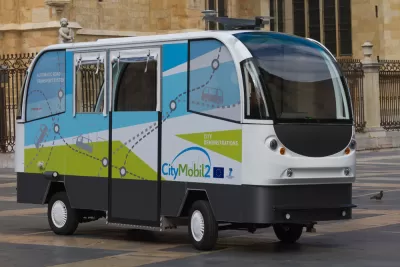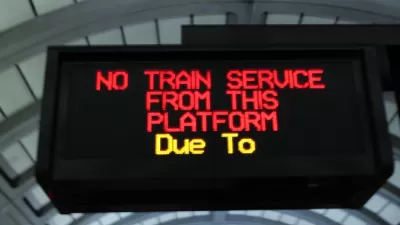TransitCenter's Steven Higashide argues that despite all the hype around self-driving vehicles, traditional high-capacity transit still has some distinct advantages. As long, that is, as transit agencies are willing to recognize them.

In a post adapted from remarks made by Steven Higashide, its director of research, TransitCenter outlines several things transit agencies should keep in mind as self-driving vehicles loom large in the public mind. "The threat that automated vehicles pose to public transit," he argues, "is a political threat."
Higashide's points include the following:
- High-capacity transit makes more efficient use of urban space than smaller vehicles, even when they're automated and/or shared.
- It'll be a while until automated vehicles can safely navigate busy urban cores and residential neighborhoods, even if they can be made functional on highways.
- Despite the high-tech veneer of public partnerships with transportation startups, "testing new technology for global motor vehicle markets for its own sake is a job for universities, research agencies, and private R&D."
- Transit systems need to become more competitive for current riders, and not simply hold out for potential tech-enabled solutions down the line.
FULL STORY: 4 Things For Transit Agencies to Remember in a World of Driverless Car Hype

Maui's Vacation Rental Debate Turns Ugly
Verbal attacks, misinformation campaigns and fistfights plague a high-stakes debate to convert thousands of vacation rentals into long-term housing.

Planetizen Federal Action Tracker
A weekly monitor of how Trump’s orders and actions are impacting planners and planning in America.

In Urban Planning, AI Prompting Could be the New Design Thinking
Creativity has long been key to great urban design. What if we see AI as our new creative partner?

Pedestrian Deaths Drop, Remain Twice as High as in 2009
Fatalities declined by 4 percent in 2024, but the U.S. is still nowhere close to ‘Vision Zero.’

King County Supportive Housing Program Offers Hope for Unhoused Residents
The county is taking a ‘Housing First’ approach that prioritizes getting people into housing, then offering wraparound supportive services.

Researchers Use AI to Get Clearer Picture of US Housing
Analysts are using artificial intelligence to supercharge their research by allowing them to comb through data faster. Though these AI tools can be error prone, they save time and housing researchers are optimistic about the future.
Urban Design for Planners 1: Software Tools
This six-course series explores essential urban design concepts using open source software and equips planners with the tools they need to participate fully in the urban design process.
Planning for Universal Design
Learn the tools for implementing Universal Design in planning regulations.
planning NEXT
Appalachian Highlands Housing Partners
Mpact (founded as Rail~Volution)
City of Camden Redevelopment Agency
City of Astoria
City of Portland
City of Laramie





























